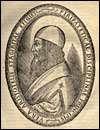|
Aristotle
Born in 384 B.C.E. the son of a physician at Stageira in Macedonia, Aristotle was one of the most noted philosophers and scientists of the ancient world. Once a student of Plato at his Academy in Athens, Aristotle adopted his own methods of inquiry different from that of his teacher. Unlike Plato, Aristotle felt that one could, and in fact must, trust one's senses in the investigation of knowledge and reality.
At Plato's death, Aristotle was not chosen to be his successor as head of the Academy and he left Athens. He eventually returned to Macedonia, where he was teacher to the young Alexander the Great. After Alexander conquered Athens and the rest of the Middle East and Egypt, Aristotle returned to Athens to found the Lyceum, a school similar to Plato's Academy. After Alexander's death, Aristotle was forced to flee Athens to the nearby island of Euboea, where he died soon afterwards in 322 B.C.E
Aristotle's writings cover a wide variety of subjects, from human and animal anatomy, to metaphysics, statesmanship, and poetry. His treatises on human anatomy are lost, but his many works on animals advocate direct observation and anatomical comparisons between species through dissection. He wrote extensively on the soul, classifying the souls of different forms of life and inanimate objects, including the earth and the heavens. Aristotle wrote extensively on animal life and both sexual and asexual reproduction, making him in many ways the founder of Western natural philosophy.
Aristotle. De animalibus.
(Venice: Iohannem de Colonia, 1476).
This first Latin edition of Aristotle’s
De animalibus was translated by Theodore Gaza, a Greek
refugee to Italy after the fall of Constantinople in 1453. The
initials are hand colored.
Aristotle.
FusikhV akroasewV … (Parisiis:
Apud Guil. Morelium, 1561).
This early edition of Aristotle includes the
Greek texts of his treatises on physics, dreams, and the soul.
Pseudo-Aristotle
Aristotle’s
Master-piece improved … (London: Printed, and sold
by the booksellers, [1766]).
Aristotle’s Master-piece first
appeared in England in the 1690s as a popular guide to human reproduction;
it was later published in more than 100 editions. Aristotle’s
name was most likely used in order to add legitimacy to the work
by claiming it had ancient, scientific sources. The true author
is unknown.
The frontispiece of nearly every edition shows
a hirsute woman and child by the desk of a scholar, most likely
depicting popular notions of the time about the causes of birth
defects.
|





